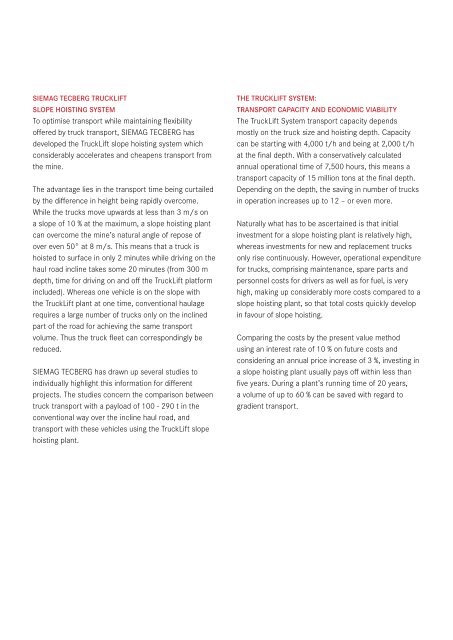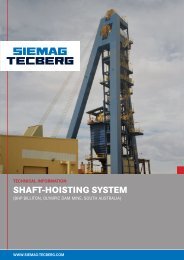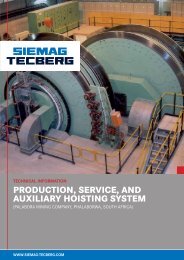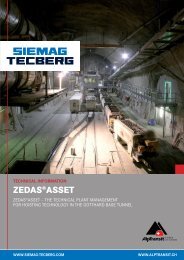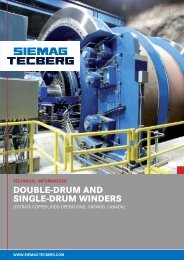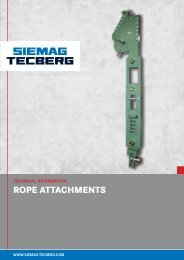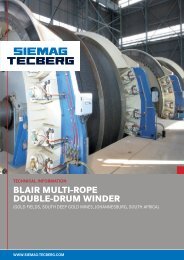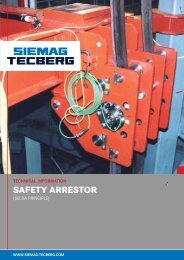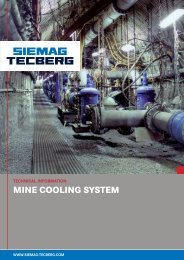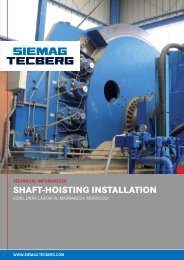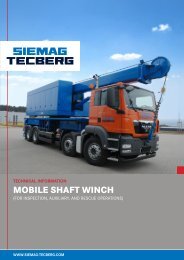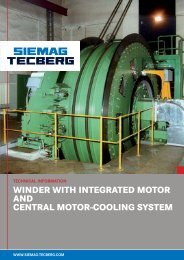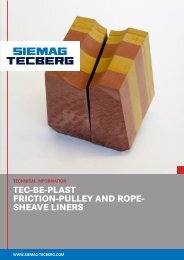TruckLift System
TI_27_Trucklift_e.pdf - Siemag Tecberg
TI_27_Trucklift_e.pdf - Siemag Tecberg
- No tags were found...
Create successful ePaper yourself
Turn your PDF publications into a flip-book with our unique Google optimized e-Paper software.
SIEMAG TECBERG <strong>TruckLift</strong><br />
slope hoisting system<br />
To optimise transport while maintaining flexibility<br />
offered by truck transport, SIEMAG TECBERG has<br />
developed the <strong>TruckLift</strong> slope hoisting system which<br />
considerably accelerates and cheapens transport from<br />
the mine.<br />
The advantage lies in the transport time being curtailed<br />
by the difference in height being rapidly overcome.<br />
While the trucks move upwards at less than 3 m/s on<br />
a slope of 10 % at the maximum, a slope hoisting plant<br />
can overcome the mine’s natural angle of repose of<br />
over even 50° at 8 m/s. This means that a truck is<br />
hoisted to surface in only 2 minutes while driving on the<br />
haul road incline takes some 20 minutes (from 300 m<br />
depth, time for driving on and off the <strong>TruckLift</strong> platform<br />
included). Whereas one vehicle is on the slope with<br />
the <strong>TruckLift</strong> plant at one time, conventional haulage<br />
requires a large number of trucks only on the inclined<br />
part of the road for achieving the same transport<br />
volume. Thus the truck fleet can correspondingly be<br />
reduced.<br />
SIEMAG TECBERG has drawn up several studies to<br />
individually highlight this information for different<br />
projects. The studies concern the comparison between<br />
truck transport with a payload of 100 - 290 t in the<br />
conventional way over the incline haul road, and<br />
transport with these vehicles using the <strong>TruckLift</strong> slope<br />
hoisting plant.<br />
The <strong>TruckLift</strong> <strong>System</strong>:<br />
Transport capacity and economic viability<br />
The <strong>TruckLift</strong> <strong>System</strong> transport capacity depends<br />
mostly on the truck size and hoisting depth. Capacity<br />
can be starting with 4,000 t/h and being at 2,000 t/h<br />
at the final depth. With a conservatively calculated<br />
annual operational time of 7,500 hours, this means a<br />
transport capacity of 15 million tons at the final depth.<br />
Depending on the depth, the saving in number of trucks<br />
in operation increases up to 12 – or even more.<br />
Naturally what has to be ascertained is that initial<br />
investment for a slope hoisting plant is relatively high,<br />
whereas investments for new and replacement trucks<br />
only rise continuously. However, operational expenditure<br />
for trucks, comprising maintenance, spare parts and<br />
personnel costs for drivers as well as for fuel, is very<br />
high, making up considerably more costs compared to a<br />
slope hoisting plant, so that total costs quickly develop<br />
in favour of slope hoisting.<br />
Comparing the costs by the present value method<br />
using an interest rate of 10 % on future costs and<br />
considering an annual price increase of 3 %, investing in<br />
a slope hoisting plant usually pays off within less than<br />
five years. During a plant’s running time of 20 years,<br />
a volume of up to 60 % can be saved with regard to<br />
gradient transport.


